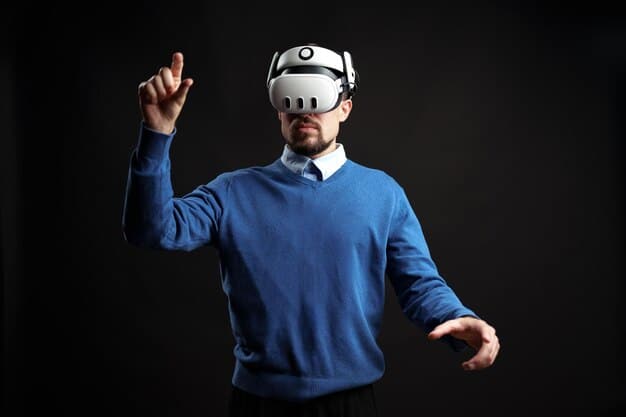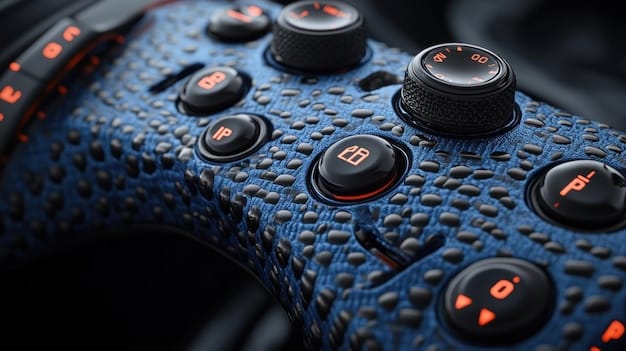The Future of Haptic Feedback: Gaming Peripherals in the Next 3 Years

The Future of Haptic Feedback: How Gaming Peripherals Will Evolve in the Next 3 Years involves more immersive experiences through advanced technologies. It promises a significant leap forward in realism and interactivity within gaming, impacting peripheral design and functionality.
Are you ready to feel the game like never before? The gaming world is on the cusp of a revolution, and it’s all thanks to haptic feedback.
Imagine feeling every explosion, every subtle texture, right through your gaming peripherals. That’s The Future of Haptic Feedback: How Gaming Peripherals Will Evolve in the Next 3 Years, promising unprecedented levels of immersion. Let’s dive in to explore how this technology will reshape our gaming experiences.
Exploring the Current State of Haptic Technology in Gaming
Haptic technology isn’t entirely new to gaming, but its current implementations are just scratching the surface of what’s possible. From basic rumble features to more sophisticated tactile feedback, the industry has been steadily building towards more immersive experiences.
Existing Haptic Feedback Systems
Currently, haptic feedback in gaming is primarily delivered through controllers, headsets, and specialized vests. These systems use various mechanisms to simulate touch sensations.
- Rumble Motors: The most common form, providing vibrations in controllers to simulate impacts and movement.
- Tactile Feedback: Found in some headsets and vests, using small actuators to create more localized and nuanced sensations.
- Force Feedback: Used in racing wheels and flight sticks to simulate resistance and the feel of driving or flying.
These existing systems offer a degree of immersion, but they often lack the precision and complexity needed to truly replicate real-world sensations. The next generation of haptic technology aims to bridge this gap.

As we look at The Future of Haptic Feedback: How Gaming Peripherals Will Evolve in the Next 3 Years, it’s clear that the limitations of current technology are driving innovation. Gamers are seeking more realistic and engaging experiences, pushing developers to explore new and improved haptic solutions.
Key Technological Advancements Driving Haptic Evolution
Several key technological advancements are poised to revolutionize haptic feedback in gaming. These innovations promise to deliver more precise, realistic, and immersive experiences, significantly altering how we interact with virtual worlds.
Advancements in Actuator Technology
One of the most significant areas of progress is in actuator technology. New types of actuators are being developed to provide more nuanced and responsive feedback.
- High-Definition Haptics: Using advanced materials and miniaturization techniques to create highly detailed tactile sensations.
- Electrostatic Haptics: Employing electrical fields to simulate textures and friction, offering a wide range of sensations.
- Microfluidic Haptics: Utilizing tiny channels filled with fluid to create precise and dynamic pressure changes on the skin.
These advancements will enable gaming peripherals to deliver a broader spectrum of tactile sensations, from the gentle caress of a breeze to the sharp impact of a bullet.
Integration of AI and Machine Learning
Artificial intelligence (AI) and machine learning (ML) are also playing a crucial role in advancing haptic technology. By analyzing game data and user interactions, AI can dynamically adjust haptic feedback to create more realistic and personalized experiences.
AI algorithms can learn from user feedback and optimize haptic responses to match individual preferences. This personalized approach will enhance immersion and engagement, making gaming experiences more compelling.

Ultimately, The Future of Haptic Feedback: How Gaming Peripherals Will Evolve in the Next 3 Years hinges on these technological advancements, promising a new era of sensory-rich gaming experiences. The integration of AI, advanced actuators, and improved sensor technology will redefine what it means to “feel” the game.
Impact on Gaming Peripherals: Controllers, Headsets, and More
The evolution of haptic feedback will have a profound impact on the design and functionality of gaming peripherals. Controllers, headsets, and other devices will need to incorporate these advanced haptic technologies to deliver truly immersive experiences.
Controllers with Advanced Haptics
Gaming controllers are set to undergo a significant transformation. Future controllers will feature high-definition haptics, allowing players to feel subtle textures, precise impacts, and nuanced environmental effects.
Controllers may also incorporate force feedback mechanisms to simulate resistance and weight, enhancing the realism of interactions. The integration of AI will enable controllers to dynamically adjust haptic feedback based on the player’s actions and the game’s events.
Haptic-Enabled Headsets
Headsets are another area where haptic feedback will make a significant impact. Haptic-enabled headsets can simulate vibrations, impacts, and environmental effects around the head and face, enhancing the sense of presence and immersion.
Imagine feeling the wind rush past your ears as you speed through a virtual landscape, or the subtle vibrations of a nearby explosion. Haptic headsets will add a new dimension to auditory experiences, making them more visceral and engaging.
The Future of Haptic Feedback: How Gaming Peripherals Will Evolve in the Next 3 Years relies heavily on the synergy between visual, auditory, and tactile feedback. This holistic approach to sensory immersion will create gaming experiences that are more believable and captivating.
Gaming Experiences Redefined: A Glimpse into the Near Future
The integration of advanced haptic feedback into gaming peripherals will redefine gaming experiences in the next three years. Players can expect more realistic, immersive, and engaging interactions with virtual worlds.
Enhanced Realism and Immersion
Haptic feedback will significantly enhance realism and immersion in games. Players will be able to feel the texture of different surfaces, the impact of weapons, and the subtle effects of the environment.
This heightened level of sensory immersion will make virtual worlds feel more tangible and believable. Players will be more deeply connected to their characters and the game environment, leading to more emotional and engaging experiences.
New Gaming Genres and Mechanics
The advent of advanced haptic feedback may also lead to the emergence of new gaming genres and mechanics. Games could be designed specifically to leverage haptic capabilities, creating unique and innovative gameplay experiences.
Imagine puzzle games where players must rely on tactile feedback to solve challenges, or adventure games where the environment responds to the player’s touch. The possibilities are endless, and The Future of Haptic Feedback: How Gaming Peripherals Will Evolve in the Next 3 Years could unlock entirely new forms of interactive entertainment.
Challenges and Opportunities in Haptic Feedback Development
While the future of haptic feedback in gaming peripherals looks promising, there are several challenges that need to be addressed. Overcoming these obstacles will be crucial to realizing the full potential of this technology.
Technological Limitations
One of the primary challenges is the technological limitations of current haptic systems. Creating precise, realistic, and reliable tactile feedback requires advanced materials, sophisticated engineering, and innovative design.
Developers must also find ways to integrate haptic technology into gaming peripherals without adding excessive weight, bulk, or cost. Balancing performance, usability, and affordability will be key to widespread adoption.
Content Creation and Integration
Another challenge is the need for content creators to integrate haptic feedback into their games effectively. Games must be designed with haptic capabilities in mind to deliver compelling and meaningful tactile experiences.
This requires new tools, techniques, and best practices for incorporating haptic feedback into game development workflows. Education and training will be essential to ensure that developers can leverage haptic technology effectively. Looking at The Future of Haptic Feedback: How Gaming Peripherals Will Evolve in the Next 3 Years involves addressing these content and integration challenges directly.
The Future of Haptic Feedback: A 3-Year Outlook
Looking ahead to the next three years, the future of haptic feedback in gaming peripherals appears bright. Several trends and developments suggest that this technology will play an increasingly important role in shaping gaming experiences.
Advancements in actuator technology, AI integration, and content creation will drive the evolution of haptic feedback. As these technologies mature, we can expect to see more precise, realistic, and immersive tactile experiences in games.
Expected Developments in Gaming Peripherals
Over the next three years, gaming peripherals are likely to become more sophisticated and feature-rich. Controllers will incorporate high-definition haptics, force feedback, and AI-driven personalization.
Headsets will also evolve to include haptic capabilities, providing tactile sensations around the head and face. Specialized vests and suits may become more common, offering full-body haptic immersion.
Consumer Adoption and Market Growth
As haptic technology becomes more affordable and widely available, consumer adoption is expected to increase. Gamers seeking more immersive and engaging experiences will drive demand for haptic-enabled peripherals.
This increased demand will fuel market growth, creating new opportunities for developers, manufacturers, and content creators. The Future of Haptic Feedback: How Gaming Peripherals Will Evolve in the Next 3 Years is closely tied to consumer adoption and market expansion.
| Key Aspect | Brief Description |
|---|---|
| 🎮 Controllers | Enhanced with high-definition haptics for realistic tactile feedback. |
| 🎧 Headsets | Integrating vibrations for immersive auditory experiences. |
| 🧠 AI Integration | AI optimizes haptic feedback based on user interactions. |
| 🚀 New Mechanics | Potential for new gaming genres designed around haptics. |
Frequently Asked Questions
Haptic feedback uses tactile sensations to enhance gaming, allowing players to “feel” in-game events. This includes vibrations, textures, and forces that make the experience more immersive and realistic.
▼
Controllers, headsets, and specialized vests are among the peripherals poised to benefit most. These devices can deliver tactile sensations directly to the hands, ears, and body, enhancing immersion.
Game development will need to integrate haptic feedback into design workflows, creating content that leverages tactile sensations. New tools and techniques will become essential to effectively use haptic technology.
▼
Yes, challenges include technological limitations, content creation, and cost. Overcoming these obstacles will ensure that haptic feedback is precise, affordable, and effectively integrated into games.
The next three years are expected to bring significant advancements, including more sophisticated controllers, haptic-enabled headsets, and increased consumer adoption, driving innovation and market growth.
Conclusion
The Future of Haptic Feedback: How Gaming Peripherals Will Evolve in the Next 3 Years is set to revolutionize the gaming world, offering unprecedented levels of immersion and realism. As technology advances, gamers can anticipate more engaging and tactile experiences.
With ongoing innovations in actuators, AI, and content creation, the coming years promise to redefine how we interact with virtual worlds, making gaming more visceral and captivating than ever before.





